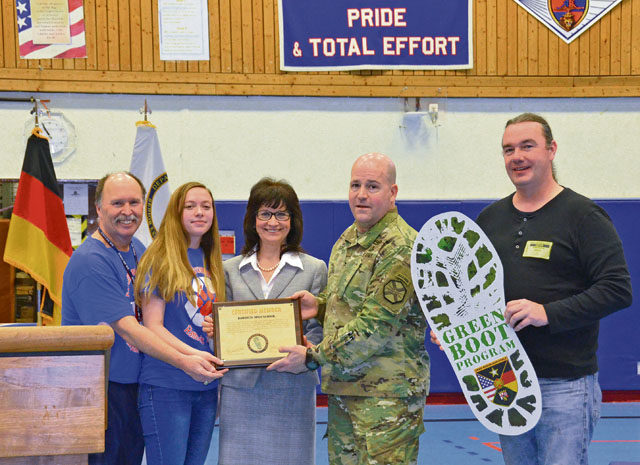
Active energy conservation plus a smaller ecological footprint equaled a Green Boot certification for Ramstein High School from the U.S. Army Garrison Rheinland-Pfalz Feb. 15.
Col. Keith E. Igyarto, USAG RP commander, presented the Green Boot certificate to RHS Principal Sharon O’Donnell, who accepted the award on behalf of her 1,010 students and faculty that made RHS the first high school in Europe to receive the certification.
“I’m proud to say that Ramstein High School is a member of the Green Boot community here in the Kaiserslautern Military Community,” Igyarto said. “There is a Native American saying, ‘We don’t own the land; we borrow it for our children.’ You as our children are setting the standard for this program, so with that, I congratulate the administrators, staff, faculty and, most of all, the students for being actively committed to this energy conservation program.”
Also there to praise the school’s efforts was Col. Curtis Juell, 86th Mission Support Group commander.
“I would like to congratulate you for the phenomenal things you’ve done with this program,” Juell said.
The commander also commented about how the RHS Environmental Club started its conservation efforts off small, “like the grain of sand inside an oyster, creating a pearl that we need to expand upon in this high school and other schools within the KMC. I encourage you to continue these practices and pass along to your parents, siblings and friends the importance of preserving our planet’s critical resources,” he said.
The Green Boot Program began in 2013 in Wiesbaden to inspire organizations to conserve energy and natural resources. The program has several conservation focus areas, to include heating, ventilation and air conditioning, awareness, waste management, transportation and water efficiency and quality. These categories help organizations diminish their ecological footprint while saving money and the environment, the garrison commander said.
“I’m so excited and proud of our students and staff who helped with this effort by increasing awareness and decreasing our environmental footprint,” O’Donnell said. “This program was possible due to the leadership of Glenn Porter, our Green Boot program manager. He was the driving force behind this endeavor.”
RHS enrolled in the program in October 2015 and chose energy reduction and awareness as its primary focus areas, said Porter, a RHS physical education teacher who inspired students to become environmentally minded and even initiated the school’s environmental club.
“We knew this would be a great program to start here at RHS because we could get everyone in the school involved,” Porter explained. “We replaced standard light bulbs with LED bulbs for lower energy consumption and longer usage. Photocopiers and printers with energy-saving modes were programmed to shut down after 15 minutes of inactivity. Computer monitors were turned off daily after school and before weekends.”
Additionally, radiators were adjusted to moderate heat settings of “3” instead of maximum “5” settings. Classrooms were lit with natural sunlight whenever possible, and a campaign to remind staff and faculty to turn off equipment and lights when not in use helped bring energy usage down, Porter said. In one year, the school reduced energy consumption by 0.89 percent, equaling thousands of dollars of savings due to the conscientious use of energy in the 136,805-square-foot school facility.
“We are so proud of our staff and students and impressed that they would take on the challenge and make these new habits part of their normal day. Both teachers and students are showing that we have an important part to play in conserving energy. We started small, but we made big steps in this program, we will keep it going,” Porter said.
Although the school started small the first year, it will add more environmental projects next year, Porter said. With both staff and student involvement, the eco attitude may spread to students’ families and others within the local communities.
It’s not just about saving money but understanding how each person in an organization can contribute to protecting resources, said Konstantin Gross, an environmental engineer with the USAG RP Directorate of Public Works Environmental office.
“Schools are the best places to run this type of program because it teaches the students the right things to focus on when it comes to the environment,” Gross said. “All actions performed by the students and staff affect their environment, making the program more visible and memorable.”
The Green Boot program falls in line with Presidential Executive Order 13514, establishing “an integrated strategy towards sustainability in the federal government and to make reduction of greenhouse gas emissions a priority for Federal agencies,” and also Executive Order 13423, “strengthening federal environmental, energy and transportation management.”
Becoming a member of the Green Boot community can be done in six steps, Gross said.
First, units should contact the USAG RP Directorate of Public Works Environmental Division to schedule an initial briefing. Next, units send their organizational chart to the Environmental Division for review. Then units will use Green Boot Program checklists to assess unit compliance with the standards. Later, when units complete their checklists, they contact the Environmental Division so they can conduct on-site checklist verification. Lastly, if the on-site verification is successful, the organization becomes a certified member of the USAG RP Green Boot program. The initial certificate is good for one year. After the initial period, it can be extended on a yearly basis by executing a recertification process.
Besides the obvious environmental benefits, other advantages of the program are recognition in the program and use of the logo on promotional materials. The Green Boot Assessment will be bundled with the annual Environmental Performance Assessment, which saves time and manpower.
“Unit participation raises ecological awareness, while wrapping together their environmental-related actions and processes to make annual program recertification easier,” Gross said. “The depth (of how much they want to do) can be decided by the organization itself.”
To learn more about the Green Boot Program, call the USAG RP DPW Environmental office at 493-4744 or 0631-3406-4744.


